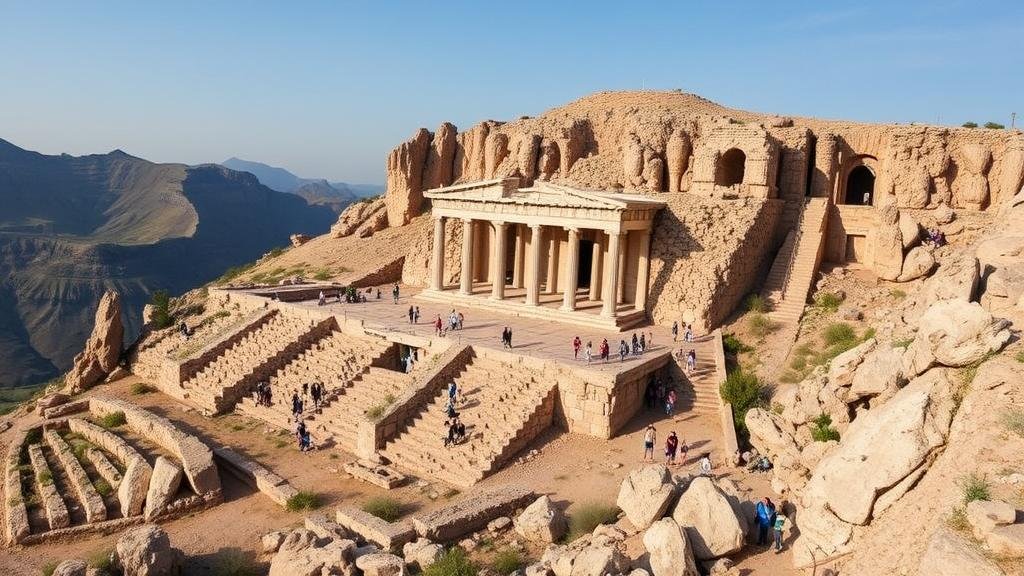Investigating the unexplored reaches of Turkey’s Mount Nemrut for hidden Hellenistic treasures.
Investigating the Unexplored Reaches of Turkey’s Mount Nemrut for Hidden Hellenistic Treasures
Mount Nemrut, a UNESCO World Heritage site located in southeastern Turkey, is renowned for its monumental statues and rich historical significance. Standing at 2,134 meters, this majestic mountain holds remnants of a once-thriving Hellenistic kingdom that flourished in the 1st century BCE. While the towering statues of gods and the enigmatic burial mound of King Antiochus I have attracted tourists and researchers alike, many of Mount Nemruts unexplored territories may harbor untold treasures from the Hellenistic era. This article delves into the archaeology, history, and potential hidden gems of this remarkable site.
The Historical Context of Mount Nemrut
Mount Nemrut is famously associated with King Antiochus I Theos of Commagene, who ruled from 62 BCE to 38 BCE. Known for his insatiable quest for power and prestige, Antiochus constructed a burial site on the mountain, replete with colossal statues, intricate reliefs, and inscriptions in Greek and Persian. The summit is adorned with the heads of gods such as Apollo, Zeus, and Hercules, symbolizing the syncretism of the Hellenistic and local cultures.
The most notable construction is the monumental tumulus (burial mound) that is believed to contain the remains of Antiochus himself. According to historical accounts, it was designed to align with celestial events, showcasing the sophisticated engineering techniques of the period. Despite the extensive studies that have taken place since its discovery in the 19th century, much of Mount Nemrut remains uncharted.
The Archaeological Potential
While the artifacts and statues on Mount Nemrut have been extensively documented, the lesser-explored regions of the site may contain valuable archaeological finds. The following aspects underscore the sites potential for discovery:
- Untapped Areas: Only a fraction of the entire mountain has been excavated, leaving large sections untouched. hills surrounding the main summit may conceal smaller sanctuaries, altars, or statues waiting to be unearthed.
- Subterranean Structures: Historical records indicate a complex of structures beneath the surface. Previous excavations have revealed remnants of ancient roads, water channels, and potential burial sites.
- Artifacts from Different Eras: The geographical significance of Mount Nemrut as a crossroads of cultures implies that artifacts from various periods, including pre-Hellenistic and Roman, could also be hidden within its depths.
Investigation Techniques
Modern archaeological methods can enhance the investigation of Mount Nemrut, enabling researchers to locate hidden treasures without extensive excavation. Techniques include:
- Ground-Penetrating Radar (GPR): This non-invasive method allows archaeologists to detect subsurface structures without disturbing the site, providing precise data on what lies beneath the surface.
- Remote Sensing: Utilizing satellite imagery and drones can help in mapping out less accessible areas of the mountain and identifying potential sites for further exploration.
- 3D Modeling: Advanced modeling techniques can reconstruct historical landscapes and structures, giving insights into the original layout of the site.
Challenges and Considerations
Despite the promising potential, several challenges exist when it comes to exploring Mount Nemrut:
- Environmental Factors: The harsh weather conditions, including extreme temperatures and heavy snowfall, can hinder excavation efforts and preservation.
- Political Stability: The regions geopolitical landscape could impact funding and safety for researchers wishing to investigate further.
- Conservation Efforts: Balancing archaeological exploration with the need to preserve this UNESCO site is paramount; excessive digging could damage existing structures.
Real-World Applications and Importance
The investigation of Mount Nemrut not only enhances our understanding of Hellenistic culture but also contributes significantly to the fields of archaeology, history, and heritage conservation. findings could:
- Enrich Cultural Identity: Recovering artifacts can help illuminate the narratives of ancient civilizations, fostering a deeper appreciation for cultural heritage.
- Boost Tourism: New discoveries can draw interest from historians and tourists alike, injecting revenue into the local economy.
- Advance Archaeological Methods: This site could serve as a model for using technology to preserve and investigate other archaeological sites around the world.
Conclusion
Mount Nemrut bears witness to an extraordinary convergence of cultures during the Hellenistic period and remains a treasure trove of archaeological intrigue. As advanced technologies pave the way for untapped discoveries, researchers are poised to uncover hidden relics that could reshape our understanding of this ancient civilization. Continued exploration and investigation of Mount Nemrut not only preserve its rich history but also inspire future generations to appreciate our shared cultural legacy.



